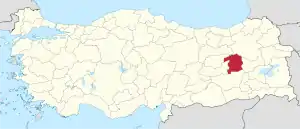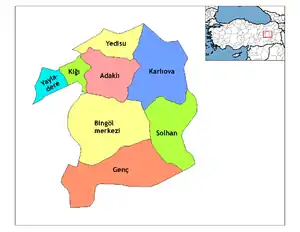Bingöl Province
Bingöl Province (Turkish: Bingöl ili; Zazaki: Suke Çolig,[2] Kurdish: Parêzgeha Çewlîgê[3][4]) is a province of Turkey in Eastern Anatolia. The province was known as Çapakçur Province until 1945 when it was renamed as Bingöl province.[5] Its neighboring provinces are Tunceli, Erzurum, Muş, Diyarbakır, Erzincan and Elazığ. The province covers an area of 8,125 km2 and has a population of 255,170. The capital is Bingöl. As the current Governor of the province, Kadir Ekinci was appointed by the president on the 5 November 2018.[6]
Bingöl Province
Bingöl ili | |
|---|---|
 Location of Bingöl Province in Turkey | |
| Country | Turkey |
| Region | Central East Anatolia |
| Subregion | Malatya |
| Government | |
| • Electoral district | Bingöl |
| • Governor | Kadir Ekinci |
| Area | |
| • Total | 8,125 km2 (3,137 sq mi) |
| Population (2018)[1] | |
| • Total | 281,205 |
| • Density | 35/km2 (90/sq mi) |
| Area code(s) | 0426 |
| Vehicle registration | 12 |
The town of Genç was the scene of origin for the Kurdish Sheikh Said rebellion in 1925 and most of the region was captured by the rebels during the rebellion.[7]
Demographics
Kurds comprise the majority of the province and the province is considered part of Turkish Kurdistan.[8][9] Its population is majority Sunni, conservative and many adhere to the Naqshbandi order.[10][11] The province moreover has a significant Alevi minority.[12] Linguistically, the southern parts of the province speak Zaza, while the northern parts speak Kurmanji. Many Zaza-speakers speak Kurmanji as well.[13]
Language and religion statistics
Bingöl Province was part of Bitlis Vilayet during the Ottoman era as Genç Sanjak and had a population of 36,011 in the 1881-1882 census. 85.7% of the population was Muslim and the remaining 14.3% was Armenian. In the census of 1897, the sanjak had a population of 47,652, of which 88.1% was Muslim and 11.9% was Armenian. All of the Armenians adhered to the Armenian Apostolic Church.[14]
In the 1906-1907 census, the sanjak had a population of 45,215 of which 86.8% was Muslim and Armenians comprised the remaining 13.2%. In the last Ottoman census in 1914, the region had a population of 38,096 of which 93.9% was Muslim and 6.1% Armenian.[15]
The first Turkish census which included Bingöl Province was the 1945 census, where the population was 75,550 who all were Muslims. Lingustically, the most spoken first language was Kurdish at 55.7%, followed by Turkish at 43.8% and Circassian at 0.4%.[16] In the 1950 census, Kurdish was the first language for 76.5% of the population of 97,328, while Turkish remained the second largest language standing at 22.9% and Circassian at 0.4%.[17] In the last census in 1965, Kurdish stood at 58.3% and Turkish at 41.6%.[18]
A 2016 survey showed that 90.4% of the population spoke Turkish, 64.1% spoke Zaza, 40.1% spoke Kurmanji and 5.6% spoke Arabic.[19]
History
From 1923 to 1929, Bingöl Province was part of Elazığ Province and part of Muş Province from 1929 to 1936. It ultimately became a province in 1936.[5]
In December 1935 the Tunceli Law was passed which demanded a more powerful government in the region.[20] Therefore the region containing the present Bingöl province, together with the provinces of Tunceli, Erzincan and Elaziğ were included in the Fourth Inspectorate General (Umumi Müfettişlik, UM) in January 1936.[21][22] The fourth UM was governed by a Governor Commander. All the employees in the municipalities were to be from the military and the Governor Commander had the authority to evacuate whole villages and resettle them in other parts of the province.[21] in 1946 the Tunceli Law was abolished and the state of emergency removed but the authority of the fourth UM was transferred to the military.[21] The Inspectorate General was dissolved in 1952 during the Government of the Democrat Party.[23]
Districts
Bingöl province is divided into 8 districts (capital district in bold):
Bibliography
- Dündar, Fuat (2000), Türkiye nüfus sayımlarında azınlıklar (in Turkish), ISBN 9789758086771
References
- "Population of provinces by years - 2000-2018". Turkish Statistical Institute. Retrieved 9 March 2019.
- Zazaca -Türkçe Sözlük, R. Hayıg-B. Werner
- "Li 26 herêmên Çewlîgê "herêmên ewlehiya taybet" hat ragihandin". Rûdaw. 11 November 2018. Retrieved 27 April 2020.
- "Genç - Bingöl". Municipality of Bingöl (in Zazaki and Turkish). Retrieved 28 April 2020.
- "Valilik Tarihçesi". www.bingol.gov.tr. Retrieved 2020-04-12.
- "Valimiz". www.bingol.gov.tr. Retrieved 2020-04-12.
- Oran, Baskın; Akdevelioğlu, Atay; Akşin, Mustafa (2010). Turkish Foreign Policy, 1919-2006. University of Utah Press. p. 159. ISBN 9780874809046.
- Watts, Nicole F. (2010). Activists in Office: Kurdish Politics and Protest in Turkey (Studies in Modernity and National Identity). Seattle: University of Washington Press. p. 167. ISBN 978-0-295-99050-7.
- "Kurds, Kurdistān". Encyclopaedia of Islam (2 ed.). BRILL. 2002. ISBN 9789004161214.
- "Turkish Town's Despair Breeds Terrorists, Residents Fear". The New York Times. 27 November 2003. Retrieved 7 January 2021.
- Ayiş, Mehmet Şirin (2018). "Bingöl ve Çevresinde Halidîliğin Yayılmasında Etkili Olmuş Sufi Şahsiyetler" (PDF). BÜİFD. University of Bingöl. 11: 183–208.
- Hamelink, Wendelmoet (2016). The Sung Home. Narrative, Morality, and the Kurdish Nation. BRILL. p. 25. ISBN 9789004314825.
- Bright, William (1992). International Encyclopedia of Linguistics. Oxford University Press. p. 231. ISBN 9780195051964.
- Karpat, Kemal (1985). Ottoman population 1830-1914. The University of Wisconsin Press. p. 196. ISBN 9780299091606.
- Karpat, Kemal (1985). Ottoman population 1830-1914. The University of Wisconsin Press. pp. 130, 162 & 174. ISBN 9780299091606.
- Dündar (2000), pp. 176-178.
- Dündar (2000), p. 186.
- Dündar (2000), p. 218.
- Bingöl İli Sosyal Analiz Çalışması (PDF) (in Turkish). Ankara: Hegem Vakfı. 2016. p. 164. ISBN 978-605-8295-10-0.
- Cagaptay, Soner (2006-05-02). Islam, Secularism and Nationalism in Modern Turkey: Who is a Turk?. Routledge. pp. 108–110. ISBN 978-1-134-17448-5.
- Bayir, Derya (2016-04-22). Minorities and Nationalism in Turkish Law. Routledge. pp. 139–141. ISBN 978-1-317-09579-8.
- Cagaptay, Soner (2006-05-02). Islam, Secularism and Nationalism in Modern Turkey: Who is a Turk?. Routledge. p. 110. ISBN 978-1-134-17448-5.
- Fleet, Kate; Kunt, I. Metin; Kasaba, Reşat; Faroqhi, Suraiya (2008-04-17). The Cambridge History of Turkey. Cambridge University Press. p. 343. ISBN 978-0-521-62096-3.
External links
| Wikimedia Commons has media related to Bingöl Province. |
- (in Turkish) Bingöl governor's official website
- (in Turkish) Bingöl municipality's official website
- Bingöl weather forecast information
- (in Turkish) Bingöl and Solhan local news website
